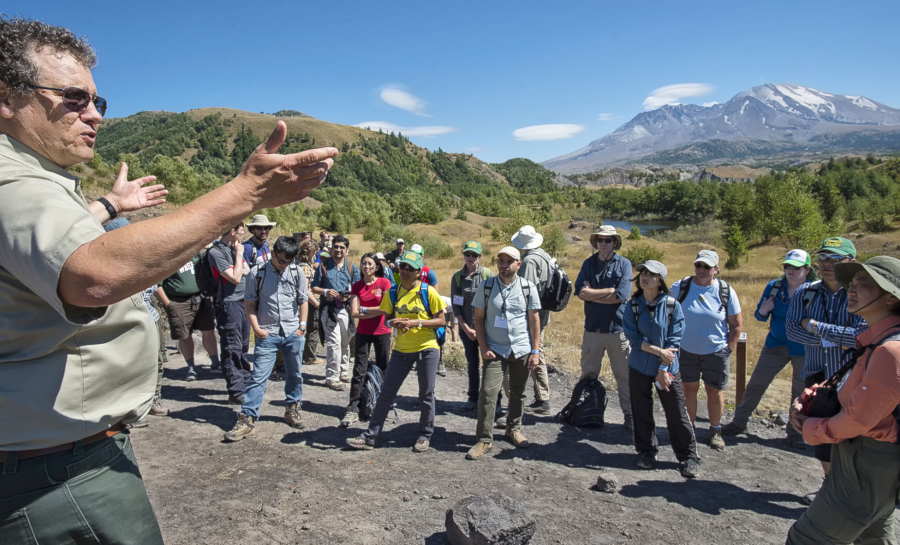LONGVIEW — Peter Frenzen has worked at Mount St. Helens for 35 years, yet he still lights up talking about the mountain.
“I’ve been many places in the world, and maybe I’m biased, but maybe the coolest places I’ve ever been, anywhere, are around Mount St. Helens,” he said. “It never ceases to amaze me. I pinch myself practically every time I’m out there.”
Frenzen, 60, who’s served as the staff scientist at the Mount St. Helens National Volcanic Monument since its creation in 1982, is retiring at the end of September. For decades, he’s been the public face of the 110,000-acre area, helping to coordinate research, document it for future generations, advocating for its protection and conveying its findings to the public. It’s a job that left him no real time for any research of his own.
“I liked doing research when I was doing it, but I personally find the promoting of the understanding of what people are learning to be more satisfying to me,” he said. “The impact of having people understand the world that we live in is not a tranquil place (is crucial).”
He has also appeared in many documentaries about Mount St. Helens, speaking about the complex but amazing evolution of natural and geological processes. Today, he’s a bit wistful when he watches some of those older productions.
“It’s actually kind of disconcerting to watch yourself age,” Frenzen said, laughing. “People will (watch these old documentaries) and say, ‘You were so young!’ ”
Frenzen, a Midwest native, said he “escaped” to the Northwest to study ecology at the University of Washington. About the time he began graduate studies at Oregon State University, Mount St. Helens erupted and he was able to study the aftereffects with some of the world’s most prestigious researchers.
“This was a once-in-a-lifetime experience,” he said about analyzing the volcano post-eruption in 1980. “I was just lucky enough to be included.”
Jerry Franklin, Frenzen’s professor and mentor at OSU, said he knew right off his young protege scientist would excel in the natural science world.
“He was always a very enthusiastic individual, and upbeat,” said Franklin, now a professor in ecosystem analysis at UW. “He brought just a tremendous amount of energy and enthusiasm to his research.”
When President Ronald Reagan and Congress created the monument in 1982, Frenzen was immediately hired as a staff scientist, a position he held for 35 years. One of his most important messages from that experience? That it’s a big misconception that the volcano’s eruption on May 18, 1980, was a freak event.
“One of the things that Mount St. Helens teaches you is, ‘Hey, (Earth) is changing, and it’s going to change,’ ” Frenzen said. “We have to be aware of what the Earth is capable of, since we’re much better off working with it than trying to push that big rock up a hill, since it’s more powerful than we are, and we live at its pleasure and benefit from it.”
Favorite spot
Frenzen’s favorite spot of the monument — he said this was not an easy choice — is Mount Margaret, where hikers can look across Spirit Lake into the crater of the volcano. The peak, located just northeast of Spirit Lake and Mount St. Helens, is around 5,800 feet tall and is in the heart of the volcano’s blast area.
From that viewpoint, Frenzen said it’s remarkable to witness how quickly vegetation and wildlife have returned.
“It’s hard almost for me to remember what it was like,” he said. “I look at photographs, and I do remember — it’s hard to forget the way the landscape looked. But it’s so different now than it was right after the eruption, that it’s almost hard to wrap my brain around that I’m standing in the same place.”
Frenzen said one of the U.S. Forest Service’s challenges in managing the monument is balancing the needs of tourists with preserving the natural landscape. He believes the U.S. Forest Service has done a solid job of walking that tightrope, even though tourists still get upset about being forced to stay on trails.
“There are 200 miles of trails people can hike, and they take you to some of the neatest places,” Frenzen said. “I know there are people that are upset that you have to stay on the trail, but you can pretty much see what you need to see from the trail. What defines the trail is the plants on the sides of the trail, and their flowers wouldn’t be there if everyone ran all over the place.”
Frenzen has received many accolades throughout his career, including the Forest Service’s 2010 Gifford Pinchot Award for Excellence in Interpretation and Conservation Education, and Educator of the Year for Forest Region 6, which includes Washington and Oregon, that same year.
In his spare time, Frenzen continues to surround himself with the outdoors. He said he loves kayaking, gardening, cross-country skiing and going on walks with his wife.
Franklin said Frenzen’s lifelong dedication to the monument has helped it greatly throughout the years.
“(Frenzen) doesn’t give up on ideas or people or activities, and because of his persistence, he’s been a very significant stabilizing influence,” Franklin said. “He’s provided a lot of continuity for what’s going on at the monument.”
Unfortunately, Frenzen said, his staff scientist position will not be replaced because of budget cuts. Still, even after retirement, Frenzen doesn’t plan on abandoning his volcano just yet — but he might explore a few other places as well.
“There are so many trails and places I haven’t hiked. Oddly enough, there are a lot of places I haven’t hiked at Mount St. Helens I’d like to hike. I plan to do a lot of hiking, travel around North America, probably also other places in the world. I’ll enjoy the time I have remaining and the friends I have and live my life.”



